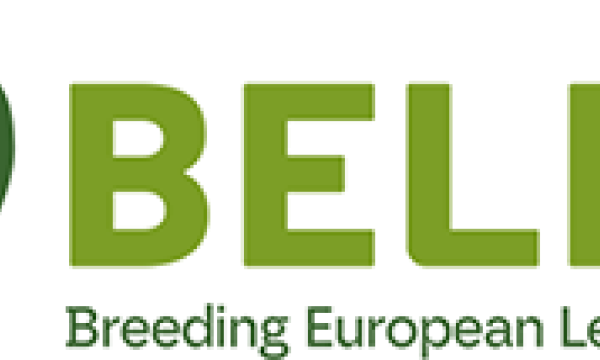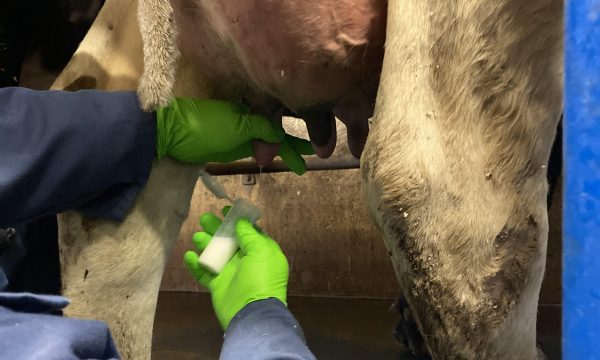Press release Methane emission reduction by one-third now possible on Flemish dairy farms.

Milk in Flanders can now be produced in a dramatically more climate-friendly way – if the latest products and strategies from scientific research are applied in practice.
The Climate and Agriculture team of ILVO, Flanders Research Institute for Agriculture, Fisheries and Food, has successfully achieved a one-third reduction in methane emissions per liter of milk during the past 4 years, as tested during a series of experiments at the ILVO farm. That is a remarkable and hope-giving result.
ILVO has developed a strong focus on researching potential and feasible climate measures for the agricultural sector in recent years. The focus is on methane, a greenhouse gas emitted by ruminants (cows, sheep, goats) during their rumination process.
ILVO has investigated three approaches to methane reduction in dairy farming: changes to feed composition, influencing methane production in the rumen using additives, and a more climate-friendly farm management.
'Climate advantages have already been achieved in each of these strategies. The combination has not yet been tested, but is certainly realistic and is planned for further research at ILVO," says Sam De Campeneere, coordinator of the ILVO Knowledge Centere for Agriculture and Climate.
Methane is 28 times powerful as a greenhouse gas than CO2 – that’s the bad news - but fortunately it breaks down 10 times faster in the atmosphere (in 12 years compared to the 100 to 200 years needed to break down CO2). Methane emissions currently account for 49% of the greenhouse gases emitted by the Flemish agricultural sector. The rest is nitrous oxide (25%) and CO2 (26%). Cattle are the main source of methane in the sector - the gas is created during the digestion of (raw) feed in the rumen and is then emitted via the cow’s mouth.
Flemish Environmental Report (2017): "The (entire) agriculture sector causes 8% of the total amount of climate emissions in Flanders." The EU calls for the agricultural sector to become 30% more climate-friendly by 2030 (reference year 2005).
Proven reduction strategies
- FEED COMPOSITION
During the VLAIO-LA project “SMART Milking”, ILVO experimented with an adapted ration for dairy cows. The traditional fraction of soy meal was replaced by the local residual streams from the food sector (beer draff and rapeseed meal). Lactating cows therefore emitted 15% less methane per liter of milk produced. Dorien Van Wesemael (ILVO): 'An additional climate advantage is that the carbon footprint (CO2) of the ration decreases because soy disappears. But that effect is not included in our figures, because such an intervention cannot be included in the local climate record.' - METHANE BRAKING MEANS FOR RUMEN FLORA
Using the gas-exchange rooms and GreenFeed feeders (installed at ILVO in 2011), ILVO has tested approximately 15 possible feed additives to see if they would permanently and favorably influence the methanogenic bacteria in the rumen (1st stomach) of the cow. Nico Peiren (ILVO): 'The best so far is a molecule developed by the international additive and vitamin producer DSM. We recorded reductions in methane emissions of 20 to 25% at a minimum. There is no deterioration due to long-term use. Other studies outside ILVO with the same additive also indicated reductions of up to even more than 50%. It is a realistic expectation that a daily additive can reduce methane emissions in the Flemish dairy barns by one-fifth to one quarter. The product is not yet on the market, however.” - BUSINESS MANAGEMENT
Every cow on a dairy farm, lactating or not lactating, emits a certain amount of methane every day as a result of digestion. The project 'Purposeful extension of life span of dairy cattle' (from Flanders’ Department of Agriculture and Fisheries, Inagro, Hooibeekhoeve and ILVO) shows two management effects that together yield at least 11% fewer methane emissions from the farm (as converted into grams of methane per liter of milk produced). Leen Vandaele (ILVO): 'We aim for a slightly younger calving (the cow calves for the first time at the age of 24 months instead of 26). Another measure is to keep the dairy cows longer, to reduce the amount of (non-lactating) heifers and to achieve a lower replacement percentage. The result of these improvements in the management of the farms gives a clear ecological and financial advantage, and therefore also a favorable climate effect.”
Why "one third"? Correct calculation is done step by step
ILVO says a “one-third reduction” using following reasoning: Assume that the total emissions to a company BEFORE applying the three above measures is equal to 100 units. Then these emissions decrease by a more climate-friendly management by 11 units to 89. The other two reduction strategies (use of additive and improved feed composition) are limited to that part of the herd that gives milk - about 70% - because the ILVO tests only happened with lactating cows (70% of 89 is 62). From that 62%, we first reduce the adjusted ration: 15% of 62 is 10.5%. Finally, we calculate the effect of the additive on the remaining units: 25% of 52.5 is 13%. Conclusion: the current theoretically feasible reduction of methane from an ordinary Flemish dairy herd is 11 + 10.5 + 13 = 34.5%. And that is with the same amount of milk produced and without the effects diminishing over time.
Future research?
The effect of measures 1 and 2 on non-lactating cows still has to be mapped out. The knowledge of the precise bacterial activity in the rumen can certainly also develop further. And the effect of the combination(s) of the 3 approaches must be further quantified. Sam De Campeneere (ILVO): "We remain committed to our research into possible methane reduction."


